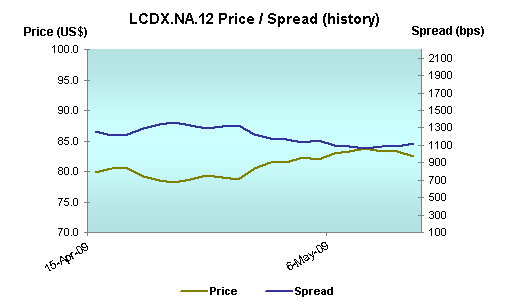
Debt seems to be a theme for me over this year. most of my purchases were in debt related instruments. I have invested in Commercial real estate debt, bank loans and the quasi debt preferred shares.
1. Purchase of bank loan Close-end-fund PHD at $6.75:
The Credit markets recovered over the few weeks particularly in the non government debt. Some of the funds that I was analyzing for investment in bank loans have moved up, some by 30%. The spread on bank loans have come down significantly from few days ago as displayed
in the chart.
There are a lot of improving signs in the credit environment:
- LIBOR is came down and it should provide significant debt service relief
- Mortgages are down to historic rates
- Corporate yields are down indicating trust in corporate paper or at least some money is moving into that market.
- even high yield rates have gone down.
- all this is accomplished with treasuries at historic lows still, i.e. the spreads are still the same but yields have came down because people are buying and capital is flowing into the credit market rather than treasuries.
2. Commercial Real Estate Debt:
I have bought NorthStar Realty (NRF), maybe prematurely in hindsight but I still like it, to capitalize on the cheapness of commercial real estate debt.
From Bloomberg:
Top-rated commercial-mortgage bonds, which returned 32 percentage points less than Treasuries in October and November, have offered a record 12 percentage points more than government notes through Dec. 24, Barclays Capital index data show.I am considering to double down in the new year on the name; I am waiting for the possible dividend cut first. NRF will make it through this crises and will have high odds of making high returns:
Debt markets are improving amid hopes that prices fell enough to account for potential defaults and as the U.S. government continues efforts to thaw credit and curb a yearlong recession. One of the AAA classes of a $7.6 billion 2007 Goldman Sachs Group Inc. commercial-mortgage-bond deal, considered a market benchmark, has jumped 24 percent, according to Ken Hackel, head of fixed-income strategy at RBS Greenwich Capital Markets.
- The company has $326 million in cash while its market cap is about $250 million.
- Its portfolio of loans are predominately prior to the 2005-2007 glut of weak underwriting and loose credit standards.
- It has underwritten all of its loans so it has first hand knowledge of its economics.
- Management owns 11% of the company so its interest is aligned with shareholders.
- It has a large portfolio of health related commercial real estate which is doing strongly and values are going up.
3. Preferred Shares
I have accumulated preferred shares in Bombardier and Brookfield Asset Management to take advantage of price volatility versus the credit worthiness and strength of their balance sheets. I will add to both of these positions in the future.
I think debt have sold off more than equities and was offering equities like return with much better security in the event of default. Investors have raced to buy Treasuries for no return and it will not be long that they will seek better yields in the credit markets.
I have an equity purchase that I will make in the new year and I anticipate to be a big chunk of my portfolio. I have been studying the company for over six months and I have gotten a very comfortable feel of its competitive advantage and prospect.
Hope you have a happy new years!

